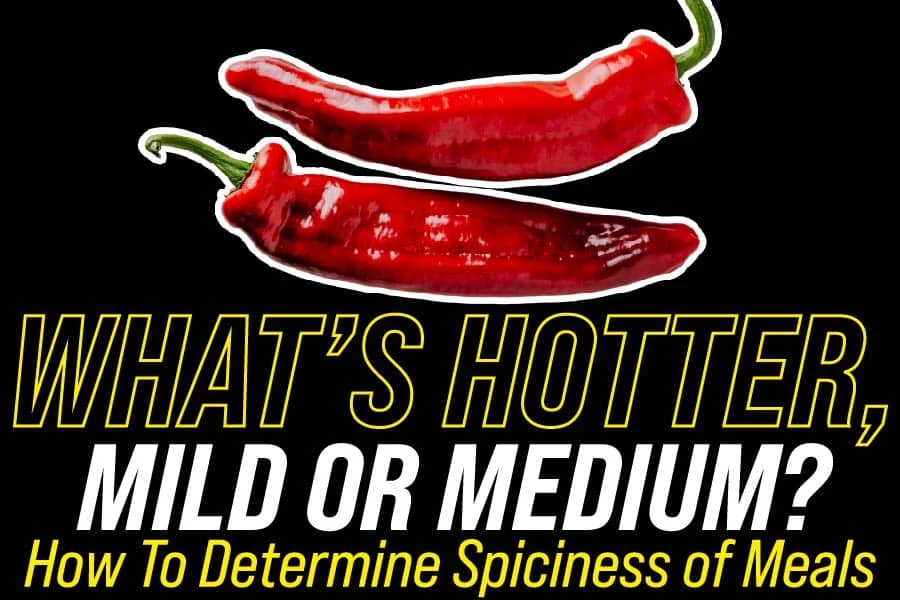You can’t talk about spices without the ubiquitous pepper. Pepper is one of the most popular plants globally, with over 4,000 varieties identified.
It comes in various shapes and sizes. It also comes in three degrees of hotness – mild, medium, and hot. And everyone has a pepper tolerance level.
This hotness is very important for chefs to consider their customers’ preferences. So, this article will examine the degrees of hotness, especially mild and medium.
What’s Hotter: Mild or Medium?
Medium is a little hotter than mild. Although the difference isn’t so much, a good taster can notice the slightly spicier taste of medium pepper. But, of course, everyone has preferences, so if you don’t like spicy sauce, go for mild instead of medium. But if you crave spicy meals, go for medium.
Categories Of Spicy Meals
There are three categories of spicy meals – mild, medium, and hot.
Mild: Mild has zero SHU and is perfect for people with a low tolerance for spicy meals.
Medium: Medium is spicier (hotter) than mild. People with low pepper tolerance can eat this meal since the difference is barely noticeable.
Hot: A hot meal isn’t for low pepper tolerance people. The hot spices are also of various degrees, and only those used to it can enjoy such meals.
How To Calculate The Spiciness Of A Meal
A meal’s spiciness also refers to how hot or mild the pepper is, and this depends on our taste buds.
In 1912, Wilbur Scoville invented the Scoville Scale. This scale measures the heat of the pepper. It does this by measuring the amount of capsaicin in each pepper.
Capsaicin is a component in pepper that determines how hot it is. So the more capsaicin a pepper contains, the hotter and spicier it’ll be.
The scale measures this in Scoville Heat Units (SHU). It measures the amount of capsaicin in pepper by diluting the extract from pepper with sugar water and estimates the number of units it’ll take till the pepper loses its heat.
The SHU ranks the pepper’s heat from mild to hot. Mild peppers rank from 100 – 2,500 SHU while the medium-range from 2,500 – 30,000 SHU. Hot peppers rank from anything 30,000 and above. Some pepper SHU runs into millions.
Mild Peppers
Pepperoncini: Also called Tuscan peppers or Sweet Italian peppers. They are sold pickled and have a light green color. They have a rating of 100 – 600 SHU.
Sweet bell peppers: This is the mildest pepper with zero SHU. It comes in orange, green, yellow, and red colors. Good for salads and sandwiches.
Banana peppers: It is sweet enough to be eaten raw. Good for salads, sandwiches, and pizza. Its color ranges from yellow to ripening red. It has a rating of 500 SHU.
Cubanelle peppers: This pepper is mild and best for sautéing. It’s also referred to as Italian frying pepper. It has a rating of 100 – 1,000 SHU.
Mild to Medium Peppers
Anaheim peppers: This kind of pepper has the shape of a dagger and a tough green body. It’s to be served cooked. It has a rating of 500 – 1,000 SHU.
Poblano peppers: They have thick dark green skins and are finger-length in size. It’s good for roasting and stuffing. It has a rating of 1,000 – 2,000 SHU.
Ancho peppers: This is the secret behind many sauces like mole. They are ripened poblanos that have been harvested and dried. It has a rating of 1,000 – 2,000 SHU.
Medium Peppers
Jalapeño peppers: This is the most popular kind of pepper, and they come in varieties that give them different heat rates. Although they are mostly harvested green, you can still find red jalapeños. They have a rating of 2,500 – 8,000 SHU.
Serrano peppers: This is a smaller version of jalapeño peppers with a smooth, glossy dark green body. They are also very popular. Best when roasted and used for salsas, sauces, and garnish. It has a rating of 6,000 – 23,000 SHU.
Chipotle: Chipotles are the red ripened, dried, and smoked jalapeños pepper. They weigh only one-tenth of the weight of jalapeños but don’t be fooled when using them because they are as hot.
Don’t measure them by their weight, but their quantity when used for cooking. When used with other ingredients, these are the chief ingredients in preparing a dish. It has a rating of 5,000 – 10,000 SHU.
Hot wax peppers: These have a striking resemblance to banana peppers, with their yellow or pale light green skins. They can be eaten raw or pickled and are used in seasoning soups, sauces, and stews. They can also be called Hungarian wax pepper. It has a rating of 5,000 – 15,000 SHU.
Hot Peppers
Bird’s eye peppers: It derives its name from its size. It’s just an inch or so in length. It was first grown in Guyana, but it’s also grown in other parts like Africa, Thailand, and India. It’s very hot. It has a rating of 100,000 – 225,000 SHU.
Bahamian peppers can be harvested when green and unripe or when red and fully ripened. There are also shades of bright yellow and Bahamian orange peppers. They have the shape of a Christmas tree light and grow in clusters with their tips pointed upwards. It has a rating of 95,000 – 110,000.
Carolina cayenne peppers: Carolina cayenne pepper is like the dried and grounded version of the cayenne pepper, but it’s two times hotter. It was grown at Clemson University and can withstand a particular crop-destroying nematode. It’s thin, long, and bright red. It has a rating of 100,000 – 125,000.
Jamaican peppers: This comes in varieties, with the hottest ones as red and yellow, while the ones with colors running from chocolate to brown are a bit mild. They have the shape of scotch bonnets, but below, they have a hamburger-style hat shape, with a crown and a brim. It has a rating of 100,000 – 200,000 SHU.
Very Hot Peppers
Habenaro peppers: It measures an inch or two in size, looks like jalapeños or bell peppers, and is named after a city in Havana. Over time, the SHU rating of the habanero pepper has increased from 350,000 to 80,000 – 600,000 SHU due to its new hot variety being bred. Its color ranges from light orange to deep orange and fiery red.
Scotch bonnet peppers: They are a favorite among the Caribbean. They’re shaped like cherry tomatoes. When matured, their color can be yellow, orange, or bright red. They have a rating of 100,00 – 325,000.
Overly hot peppers
- Carolina reaper with a rating of 2.2million SHUs
- Trinidad moruga scorpion with a rating of 2.2million SHUs
- Naga viper with a rating of 1.4million SHUs
- Trinidad Scorpion “Butch T” with a rating of 1.4million SHUs
- Bhut Jolokia, otherwise known as ghost peppers, with a rating of 1million SHUs
How To Stop A Burning Sensation When You Eat Spicy Meals
Maybe you just discovered that a particular meal is too spicy for you when it’s already in your mouth. The best way to kill that burning and probably painful sensation isn’t to use water. A lot of people try using water, but it never relieves it. It can cool for a few seconds, but that’s just as temporary as using water can get.
The best way to stop the burning sensation is to take any citrus-type food, fruit, or drink. You can take lemon, lime, pineapple, orange, etc.,
When cooking a meal and discovering it’s too spicy, you can add a bit of citrus or any edible acidic substance. It’ll help reduce the spiciness to a bearable minimum.
How To Develop Your Taste Bud To Eat Spicy Meals
Don’t rush the meal:
Don’t rush it when you’re eating a highly spicy meal. Instead, eat slowly to enable your system to have enough time to adjust to the new regime. While eating, because you’re not used to it, the burning sensation will feel almost unbearable, but if you eat slowly, you’ll notice you’ll get a bit used to it and even enjoy it before the meal is over.
Small beginnings:
Don’t push yourself too much. You can start with pepper with medium ratings, and build up from there, except you can handle more spice. When you start small, it gives your body time to adjust to each level of spice increase. However, if you begin to feel sick, stop with the spice and allow your body to heal before you continue.
Know your limitation:
While some people are good to go with hot spicy meals, others can’t, and the evidence of their trial is the tears in their eyes. So if you’ve tried very spicy meals and you can’t contain the heat, don’t force it. Instead, stop and stick with hot but not very hot meals.
Increase the heat gradually:
If you’re pepper tolerant, you can easily move on to spicier meals and get used to them. If you aren’t, begin with mild meals, and change your meals from time to time. Better still, you can alternate between hot and mild meals till you find your bearing.
Keep a coolant close by:
When learning how to eat hot meals, It’s advisable to keep a coolant nearby, just in case. For example, you can get dairy products or citrus products, so you don’t burn your tongue and have a painful scar even before you start.
Conclusion
Mild and medium describes the degree of hotness of pepper, the world’s most popular spice. Although most people love pepper, everyone has a degree of pepper tolerance.
Medium is a little hotter than mild and is comfortable for many people. The third level, hot, is a scale upon the intensity.
Chefs would find this distinction useful to keep their customers satisfied. Giving a hot peppery dish to an intolerant client can cause a lot of stir.
 Being Human
Being Human





